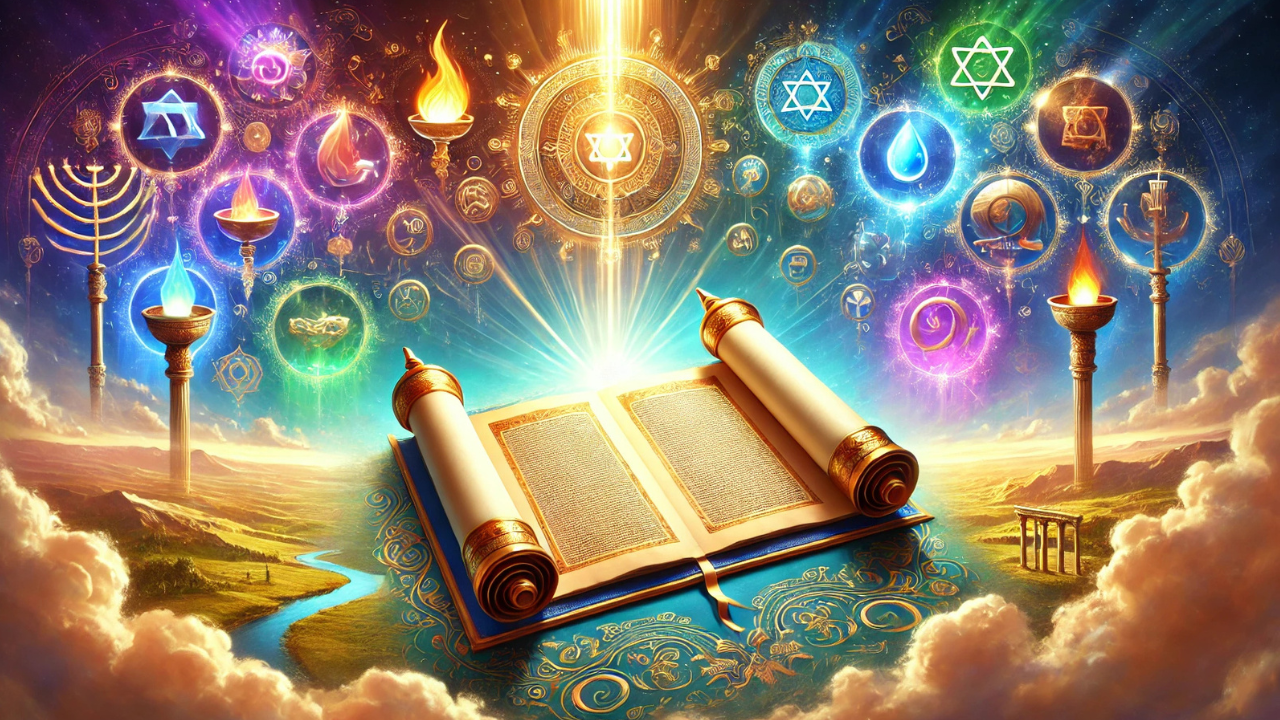The Torah portion of Vayakhel begins with a brief description of Shabbat, while then the rest of the portion deals exclusively with building the Tabernacle as commanded by God. All of the commentators ask why Shabbat is discussed here when virtually the entire portion deals with a different subject altogether. Different answers are proposed and we will briefly mention four perspectives. The first is that Shabbat is mentioned here as a clear warning that building the Tabernacle does not supersede the sanctity of Shabbat. By juxtaposing Shabbat in the Tabernacle here and in a number of other places in the Torah, we are taught the fundamental connection between the types of work done in order to build the Tabernacle and the types of work that are forbidden on Shabbat. On a more spiritual level the juxtaposition teaches us about the nature of holy time and holy space. More mystically, and yet based on modern physics, the Torah is alluding to the essential unity between the dimensions of time and space.
Having said this, a fundamental question remains. The two and half portions describing the Tabernacle before the sin of the Golden Calf actually concludes with a description of Shabbat with a similar type of warning of forbidden work on Shabbat. Coming at the conclusion of the description of the Tabernacle is understood to mean that the sanctity of Shabbat overrides the need to build the Tabernacle. Therefore, we can ask – why does the Torah have to repeat in Vayakhel the same warning again. The simple, logical, straightforward answer is that according to Rashi and other commentators the description of building the Tabernacle which comes before the sin of the Golden Calf in the Torah is only being revealed to the people now, therefore another warning is warranted. Yet, perhaps even deeper reasons can be offered.
Firstly, we note that the description of Shabbat in the portion of Ki Tisa comes at the end of the description of the Tabernacle, whereas in the portion of Vayakhel it comes at the beginning. This may be connected to the two different ways that we refer to and relate to Shabbat. In some places in the Torah Shabbat is referred to as Yom Hashvi’i, “the seventh day,” or simply as Shabbat. Each description emphasizes a different aspect of the holy day. The seventh day relates to Shabbat coming at the end of six days of work and is thus the conclusion, the seventh day of the week. Shabbat and the other hand has an additional aspect as stated in the Zohar – that all blessing for the coming week emanates from Shabbat. Therefore, we can see that Shabbat is both the conclusion of one week and the source of blessing for the coming week. Of course, both of these perspectives are true and meaningful and can be seen in the two mentions of Shabbat we are discussing here. At the end of six days of building the Tabernacle Israel should rest; when building the Tabernacle Israel should approach that holy task infused with the spiritual ambiance of Shabbat.
It is important to mention that just as Shabbat is discussed in different places in the Torah, so too are many other mitzvot as well. Yet each time, some new aspect of the mitzvah is revealed, even when at first glance they may seem similar. In our portion of Vayakhel the idea of not starting a fire on Shabbat is mentioned for the first and only time in the Torah: “You shall not kindle fire in any of your dwelling places on the Sabbath day” (Exodus 35:3). We can use fire on Shabbat, we are just forbidden to kindle a new light. The Karites and other groups who did not accept the oral tradition understood this to mean that no fire could be used on Shabbat and therefore they literally sat in the dark and ate cold food on Shabbat.
As we mentioned above, the juxtaposition of Shabbat and the Tabernacle is the basis of the oral tradition that there are thirty-nine primary types of creative work that are forbidden on Shabbat as they are the very types of creative work done in the Tabernacle. Yet the Torah only mentions two of them: making a fire, as described in this portion, and not travelling beyond a certain distance on Shabbat.
Therefore, not kindling fire becomes representative of not only all forbidden works on Shabbat but what fire symbolizes on many different planes of reality. Fire manifests itself in many ways both positive and negative. Life through the ages and especially modern life is very much based on the ability to harness the element of fire and the parallel electromagnetic force. A few examples include heating and lighting our home, work and entertainment places, modes of transportation, modern ways of healing, industry and technology. Thus, not kindling light on Shabbat represents the full gamut of ceasing all the typical types of work forbidden on Shabbat. On the negative side, the power of physical fire to destroy can unfortunately be seen in the constant results of both urban and forest fires that wreak havoc on all who are in its path. One spark lit in the wrong time and in the wrong place can quite literally burn millions of acres of forest. Not starting fires on Shabbat represents not even opening the door to these kinds of destructive events.
Beyond not kindling fire on the physical level on Shabbat, spiritually the instruction to not kindle fire applies on an emotional and intellectual level as well. The fiery emotions of anger, resentment, jealousy and hatred, or the intellectual turmoil of doubt, anxiety, moral predicaments, and difficult decision-making all must be put to the side in order to even begin to enjoy the spiritual bliss of Shabbat.
Yet, just like on the physical level, fire has many very positive uses and applications, so too spiritually. There is the positive fire of the soul and its natural tendency to flame upwards like a candle, always seeking to ascend spiritually. Just as we are not forbidden from using fire and light on Shabbat, rather not to kindle new light, using our already existing inner light is not only permitted but encouraged. We actually begin Shabbat by lighting candles right before Shabbat as a way to draw down new light before the Shabbat which will then inspire and enlighten the entire Shabbat experience.
There are also emotional and intellectual types of fire that can be harnessed for the good or can turn destructive like the fire of passion, desire, drive for accomplishment, zealousness etc. Therefore, the meaning of not kindling fire on Shabbat entails an ability to master on a certain level our emotions and thought processes so that we can step back, relax and not reach burnout. On the other hand, Shabbat is an opportunity to direct the natural and positive fire of the soul to flame upwards and connect to all of the spirituality and light that the soul longs to experience.
In the sefirot the element of fire is associated with the left side, the side of gevurah, might and strict judgment, whereas the element of water is associated with the right side, the side of chesed, lovingkindness. The command not to kindle light on Shabbat and all that it implies entails stepping back, minimizing and putting to rest the destructive feelings and thoughts connected to strict judgment. This idea is beautifully expressed in the mystical passage from the Zohar that is recited by many congregations during the Kabbalat Shabbat Service at the beginning of Shabbat. Part of that passage reads as follows:
“As Shabbat arrives, she merges into oneness, and is separated from the other side, and all strict judgments are severed from her. And she remains in unity with the holy light and crowns herself with many crowns for the holy King. Then all powers of wrath and all adversaries flee from her and vanish, and no other power rains in any of the worlds. Her countenance is irradiated with a supernal light, and she crowns herself here below with the holy people, all of whom are crowned with new souls.”
This mystical passage describes how the intrinsic spirituality and light of Shabbat has the power squelch and eliminate all vestiges of negativity from the previous week, showering those who enter into her magical realm with peace, light and contentment. For sure an individual must do their part in cutting loose from all possible negative feelings and thoughts but when the effort is made the overwhelmingly positive power of Shabbat can perform miracles for body, mind and soul.
It should be noted that Jewish law dictates that the court system does not operate on Shabbat. For as we just explained, Shabbat and judgment do not go together.
Rabbi Shlomo Carlebach adds another perspective to the comparison of these two Shabbats. Moses gathered all the people the day after Yom Kippur and told them about Shabbat, and only after, about the Tabernacle. Thus, he was imparting an important message that although the people were together when receiving the Torah at Sinai and were already keeping the Shabbat, yet, obviously there was something missing in the way they were keeping Shabbat. So, by gathering all of the people together he was telling them that in order not to make the same mistakes again that led to making the Golden Calf, we need to not only observe the laws of Shabbat but we have to do it so much deeper, we have to be so much closer to each other and to God (See Even Shlomo; Parshat Vayakhel; Edited by Rabbi Shlomo Katz).
In many other talks that Rabbi Carlebach imparted over the years he emphasized the idea that even something as holy as the Shabbat can turn into rote and routine. He was always urging people to embrace each and every Shabbat as a spiritual treasure that only comes once. In other words, we should strive to make every Shabbat the highest one yet.
Further, Moses was teaching the people that in order to create a Sanctuary for God in this world, a place where man and God could meet and commune, it needed to be infused first and foremost with the holiness of Shabbat. As important and positive the six days of work are, they ultimately receive their blessing from Shabbat. This can be seen in the words of the beloved song Lecha Dodi sung universally at the beginning of Shabbat: “The end of deed [Shabbat] is the first in thought.” This idea can be seen in one of the permutations of the first word of the Torah, bereishit, (בראשית) being yirah-Shabbat (ירא-שבת), “the awe of Shabbat.” Although Shabbat was the last in creation it was first in thought, encoded “in the beginning.”
There is a tradition that if the Jewish people as a whole would observe two Shabbats, the Mashiach would come. Many commentators express that even one Shabbat that contains two elements – refraining on one hand from all that is forbidden, while at the same time receiving the experience of Shabbat with great joy and spiritual bliss – this would bring Mashiach. Thus, in a sense, there is no disagreement between these two interpretations, as one Shabbat would be like two. Similar to how Moses introduces in our Torah portion the building of the Tabernacle with instructions regarding Shabbat, so too, is the hope that when all of Israel will keep Shabbat on the highest, deepest manner, it will bring redemption and the rebuilding of the Third Temple. May we merit to do our part in manifesting this reality.







